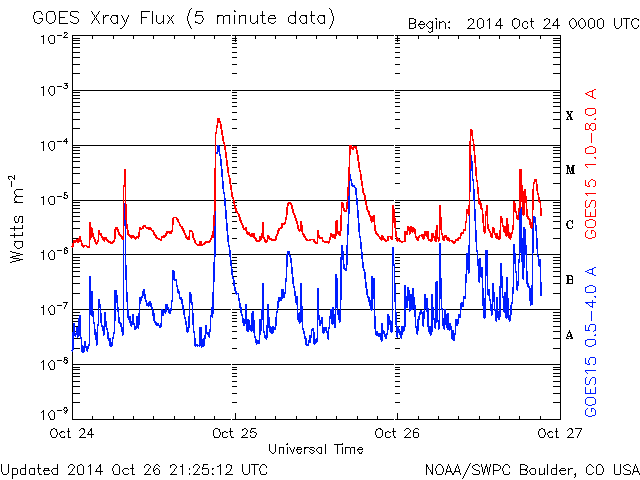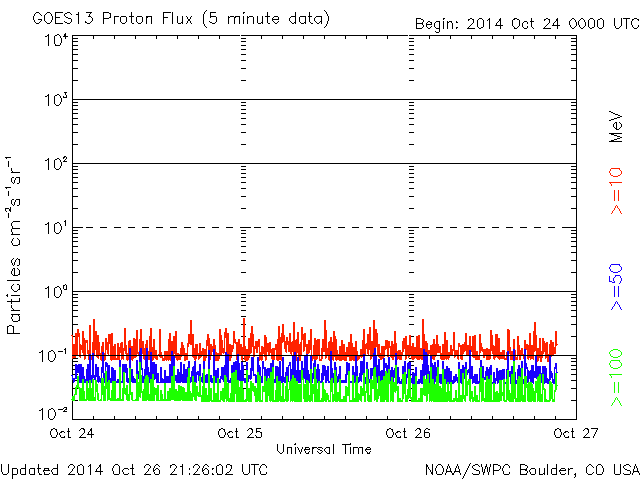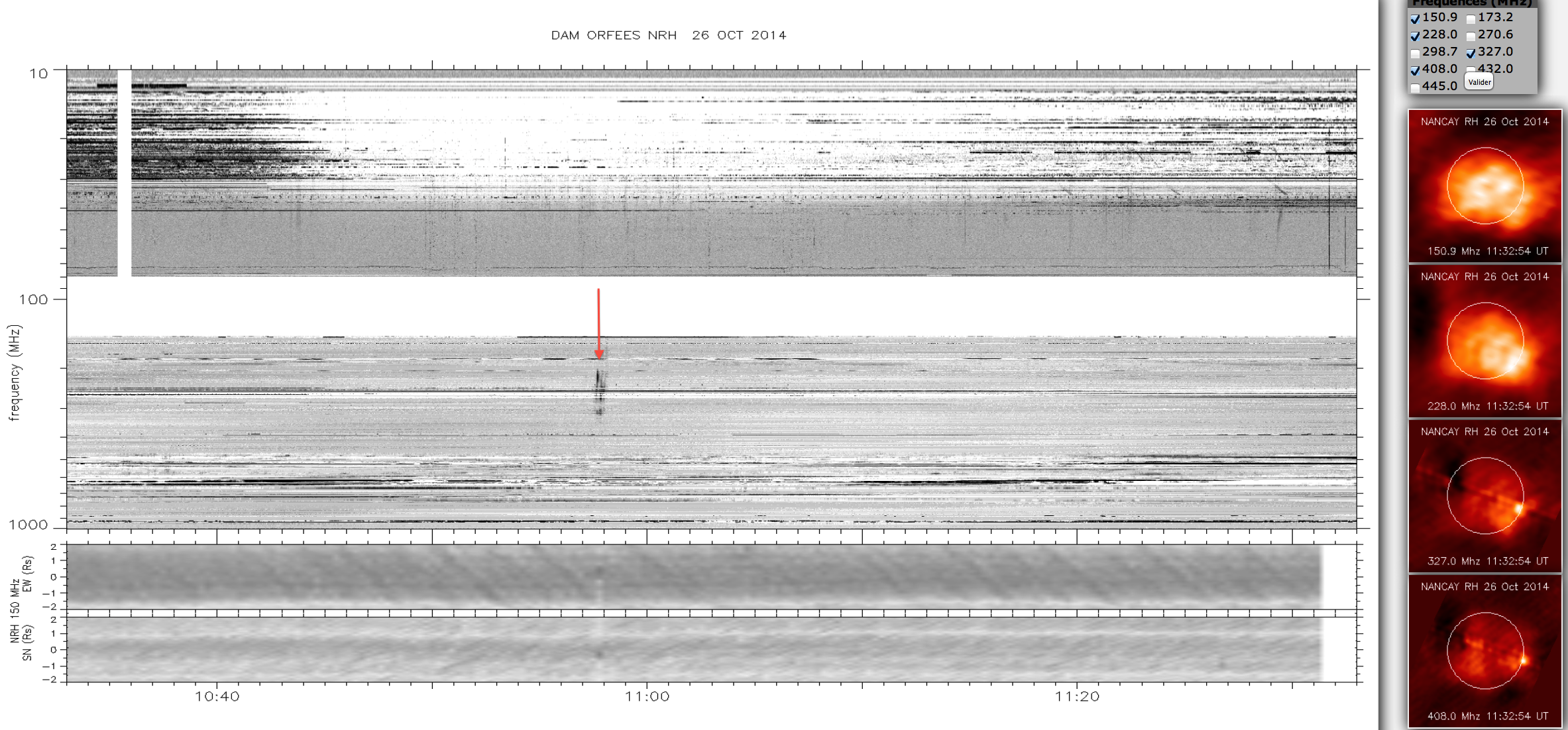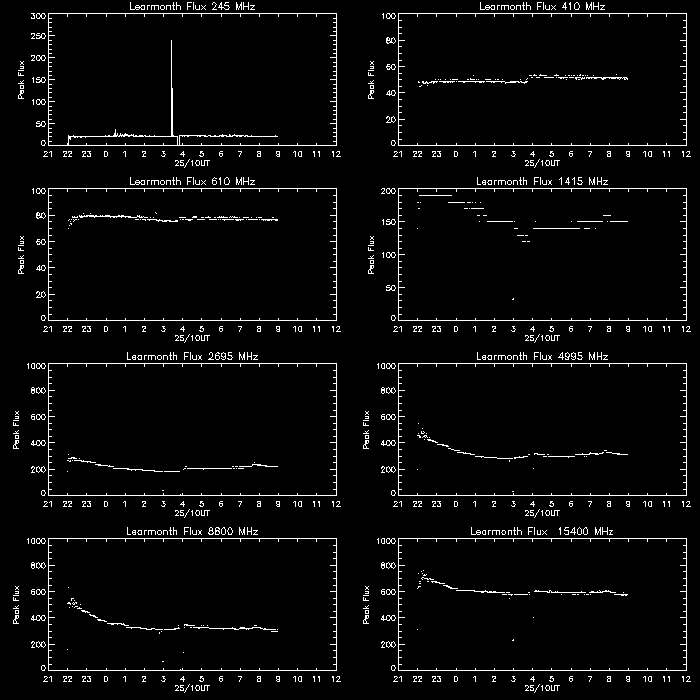|
A series of strong X-ray bursts on 2014 October 24-26 without solar energetic particle events at the Earth ! On 2014 October 24-26 three solar flares with soft X-ray bursts of strength X1 to X3 -amongst the strongest bursts of the present cycle of solar activity- were reported in active region NOAA 12192. The time histories of the X-ray emission is shown in the top panel of Fig. 1. The parent active region was situated in the western solar hemisphere, which usually enables a magnetic connection to the Earth. Given the strength of the soft X-ray bursts and the magnetic connection to the Earth, major solar energetic particle events (SEP events) could have been expected to be observed near the Earth, and had been predicted by some real-time forecast models. But the GOES spacecraft, which monitor the energetic particle environment at geostationary orbit, did not detect any signal above background in proton intensities at energies above 10 MeV (bottom panel of Fig. 1): no SEP event occurred with either of the three flares ! 2014 October 24 and 25 The X-ray burst started at 21:07 UT and reached maximum flux (X3.1) at 21:40 UT (SolarMonitor). The X-ray and EUV emission created a major disturbance of radio communications on Earth (Space Weather Prediction Center). The parent active region was situated at S22 W21. On October 25 a slightly weaker burst occurred at 16:55 (S10 W22), again without any SEP event at Earth. Overview plots of the data from several radio observatories on October 24 give a hint at why there was no SEP event:
2014 October 26 The third burst occurred on Oct 26 (start 10:04 UT, peak 10:56 UT, flux X2.0 at S14 W46), at a time when the radio spectrographs of the Nancay Radio Observatory in central France (Nancay Decametre Array DAM and ORFEES) and (the Nancay Radioheliograph (NRH)) observed the Sun. These instruments provide real-time monitoring observations of the Sun at frequencies below 1 GHz. One summary plot is shown in Fig. 2, for the time interval 10:30-11:30. The radio spectra from the whole Sun observed by DAM show no solar bursts, only artificial terrestrial emitters. The ORFEES spectrograph shows a weak solar emission between 200 and 300 MHz near 10:58, indicated by a red arrow. This emission is fairly common and has no direct relationship with the strong X-ray burst. The radio images on the right side of the figure display at low frequencies (151 and 228 MHz) the usual extended emission of the quiet solar corona. At the higher frequencies, localised moderately bright sources are seen, but no bright emission related to the strong X-ray burst. So here again we note the absence of conspicuous radio emission below 1 GHz that would indicate the access of energetic electrons accelerated during the flare to the high corona. Summary The succession of three strong X-ray bursts in the western solar hemisphere without any signature of energetic particles reaching the space environment of the Earth is an exceptional phenomenon. But similar individual events had been investigated in the past by the solar physics group at LESIA/Paris Observatory (First Abstract)(Second Abstract). The interpretation is that particles -electrons, protons and ions- are accelerated in complex magnetic fields in the low corona, as a counterpart to the strong X-ray bursts, but that in these particular events they do not get access to open magnetic field lines that would lead them into the high corona, and afterwards to the interplanetary space. The high-energy particles accelerated during the flare remain confined in the low solar corona. In addition, there seems to be no other accelerator available in these events, such as the shock of a fast coronal mass ejection. This can also be understood if the energy release remains confined to regions of strong magnetic fields in the low corona, which prevent the configuration from erupting into a coronal mass ejection. Contact: Karl-Ludwig Klein, LESIA Observatoire de Paris, CNRS, Meudon More information on solar flares (in French):


Fig. 1: Evolution of the solar X-ray emission (top) and the intensities of energetic protons near Earth, observed by the GOES satellites (NOAA) in geostationary orbit between October 24 and 26 (www.solarmonitor.org).  (Agrandir l'image - For a large view)
(Agrandir l'image - For a large view)
Fig. 2: Screenshot of the monitoring observations of solar radio emission on October 26 with the suite of Nancay instruments: the Decametre Array (DAM; top) in the 10-80 MHz range, the ORFEES spectrograph (middle) between 130 MHz and 1 GHz (1000 MHz), and the Nancay Radioheliograph (NRH), which observes images of the radio sun at selected frequencies between 150 and 450 MHz (bottom panel and images on the right side).The grey level plots give the radio flux, dark shading means bright emission. Radio observations from ground see the Sun, but also terrestrial emitters. The terrestrial emitters (parallel horizontal lines) dominate these spectra. The only conspicuous solar emission is indicated by the red arrow. | |







